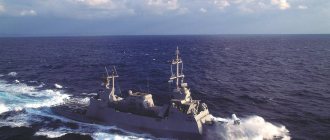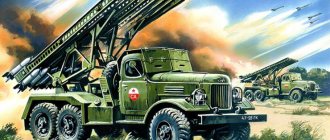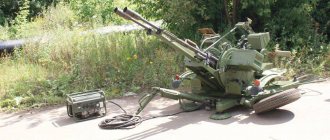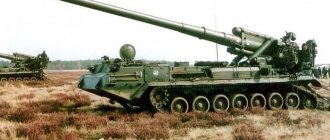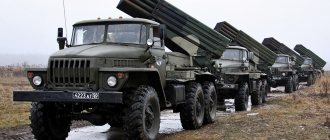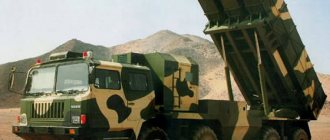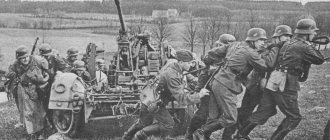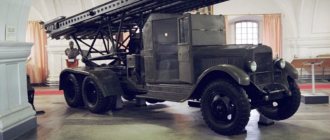The barrelless field rocket artillery system, which received the affectionate feminine name “Katyusha” in the Red Army, without exaggeration, became probably one of the most popular types of military equipment of the Second World War. In any case, neither our enemies nor our allies had anything like this.
Initially, barrelless rocket artillery systems in the Red Army were not intended for ground battles. They literally descended from heaven to earth.
The 82 mm caliber rocket was adopted by the Red Army Air Force back in 1933. They were installed on fighters designed by Polikarpov I-15, I-16 and I-153. In 1939, they underwent baptism of fire during the fighting at Khalkhin Gol, where they performed well when shooting at groups of enemy aircraft.
In the same year, employees of the Jet Research Institute began work on a mobile ground launcher that could fire rockets at ground targets. At the same time, the caliber of the rockets was increased to 132 mm. In March 1941, field tests of the new weapon system were successfully carried out, and the decision to mass produce combat vehicles with RS-132 rockets, called BM-13, was made the day before the start of the war - June 21, 1941.
How was it structured?
The BM-13 combat vehicle was a chassis of a three-axle ZIS-6 vehicle, on which a rotary truss with a package of guides and a guidance mechanism was installed. For aiming, a rotating and lifting mechanism and an artillery sight were provided. At the rear of the combat vehicle there were two jacks, which ensured its greater stability when firing. The missiles were launched using a hand-held electric coil connected to a battery and contacts on the guides. When the handle was turned, the contacts closed in turn, and the starting squib was fired in the next projectile. The explosive material in the warhead of the projectile was detonated from both sides (the length of the detonator was only slightly less than the length of the explosive cavity). And when two waves of detonation met, the gas pressure of the explosion at the meeting point increased sharply. As a result, the hull fragments had a significantly higher acceleration, heated up to 600-800 ° C and had a good ignition effect. In addition to the body, part of the rocket chamber also burst, which was heated from the gunpowder burning inside; this increased the fragmentation effect by 1.5-2 times compared to artillery shells of the same caliber. That is why the legend arose that Katyusha rockets were equipped with a “thermite charge”. The “thermite” charge was indeed tested in besieged Leningrad in 1942, but it turned out to be unnecessary - after the Katyusha salvo, everything around was burning. And the joint use of dozens of missiles at the same time also created interference of blast waves, which further enhanced the damaging effect.
Cute name for a formidable machine
There are several speculations about how the BM-13 was nicknamed “Katyusha”. The first and most popular version is associated with the famous song “Katyusha,” which appeared on the eve of the war and immediately won people’s love. “Katyusha came ashore... She came out and started a song...” - these words have been associated with the famous combat vehicle for many years. And “Katyusha” really “sang”.
“When rockets fly, a peculiar sound is heard due to the outflow of powder gases from the rocket engine. According to the well-known Doppler effect, the pitch of the sound changes as the projectile moves away. In this case, a semblance of melody arises, which distinguishes Katyusha salvoes from artillery shots. There’s no way you’ll confuse it,” said an employee of the M.V. Center in an interview. Keldysh, candidate of technical sciences Albert Gafarov.
The second version is related to . The first production BM-13s were manufactured at this Voronezh plant and had a logo in the form of the letter “K” on the cockpit door. This hypothesis is indirectly confirmed by the fact that the soldiers nicknamed the M-20 howitzer with the letter “M” “Mother”. By the way, there were other similar names in the Soviet army. For example, the M-30 installation was called “Andryusha”, and the German Nebelwerfer mortar received the Russian name “Vanyusha”. German soldiers treated our “Katyusha” with trepidation and nicknamed it “Stalin’s organ”. The BM-13's guiding machines really resemble organ pipes.
Baptism of fire near Orsha
The first salvo of a battery of Soviet rocket-propelled mortars (this is how the new type of military equipment began to be called for greater secrecy) consisting of seven BM-13 combat installations was fired in mid-July 1941. This happened near Orsha. An experienced battery under the command of Captain Flerov launched a fire strike at the Orsha railway station, where a concentration of enemy military equipment and manpower was noticed. At 15:15 on July 14, 1941, heavy fire was opened on enemy trains. The entire station instantly turned into a huge cloud of fire. On the same day, the Chief of the German General Staff, General Halder, wrote in his diary: “On July 14, near Orsha, the Russians used weapons unknown until that time. A fiery barrage of shells burned the Orsha railway station and all the trains with personnel and military equipment of the arriving military units. The metal was melting, the earth was burning.”
The morale effect of the use of rocket mortars was stunning. The enemy lost more than an infantry battalion and a huge amount of military equipment and weapons at the Orsha station. And Captain Flerov’s battery dealt another blow on the same day - this time at the enemy crossing over the Orshitsa River. The Wehrmacht command, having studied the information received from eyewitnesses of the use of new Russian weapons, was forced to issue a special instruction to its troops, which stated: “There are reports from the front about the Russians using a new type of weapon that fires rockets. A large number of shots can be fired from one installation within 3-5 seconds. Any appearance of these weapons must be reported on the same day to the general commander of the chemical forces at the high command.” A real hunt began for Captain Flerov's battery. In October 1941, she found herself in the Spas-Demensky “cauldron” and was ambushed. Of the 160 people, only 46 managed to reach their own. The battery commander himself died, having first made sure that all the combat vehicles were blown up and would not fall into enemy hands intact.
Operation Katyusha
During the first use, it was clear that even a small number of vehicles could produce stunning results from combat use. Shells can destroy railways, destroy infantry, military resources, buildings and equipment. And the first launch showed all these “abilities” of the BM-13. The explosive force from the new weapons of the USSR was so strong that the General Chief of the Reich, F. Halder, wrote that even the earth melted at the site of the explosions.
Operation Katyusha was the first near Orsha, because it was there that the Germans were most likely based and retained a large amount of military resources, and there were also most likely Russian reserves that they did not have time to take out before being captured by the Germans.
Expert opinion
Grechko Petr Olekseevich
Sociologist, researcher of the history of the USSR, expert in the field of socialism, studied Marxism, Leninism and the period of World War II.
The battery was accompanied by an entire tank division and it was a very risky mission, in which the order was given to destroy the BM-13 so that the opponents would never get it. It is this order that the troops will carry out, but much later, when the Germans surround them in the Vyazma area.
Commander-in-Chief Flerov died in this operation along with Katyusha, and he was awarded the title of Hero.
On land and sea...
In addition to the BM-13, in the SKB of the Voronezh plant. The Comintern, which produced these combat installations, developed new options for placing missiles. For example, taking into account the extremely low cross-country ability of the ZIS-6 vehicle, an option was developed for installing guides for missiles on the chassis of the STZ-5 NATI tracked tractor. In addition, an 82 mm caliber rocket has also found use. Guides were developed and manufactured for it, which were later installed on the chassis of the ZIS-6 vehicle (36 guides) and on the chassis of the T-40 and T-60 light tanks (24 guides).
A 16-charging installation for RS-132 shells and a 48-charging installation for RS-82 shells for armored trains were developed. In the fall of 1942, during the fighting in the Caucasus, 8-round mining pack launchers for RS-82 shells were manufactured for use in mountain conditions.
Later they were installed on American Willys all-terrain vehicles, which came to the USSR under Lend-Lease. Special launchers for 82 mm and 132 mm caliber missiles were manufactured for their subsequent installation on warships - torpedo boats and armored boats.
The launchers themselves received the popular nickname “Katyusha”, under which they entered the history of the Great Patriotic War. Why Katyusha? There are many versions on this matter. The most reliable - due to the fact that the first BM-13 had the letter “K” - as information that the product was produced at the plant named after. Comintern in Voronezh. By the way, the cruising boats of the Soviet Navy, which had the letter index “K,” received the same nickname. In total, 36 launcher designs were developed and produced during the war.
And the Wehrmacht soldiers nicknamed the BM-13 “Stalin's organs.” Apparently, the roar of the rockets reminded the Germans of the sounds of a church organ. This “music” clearly made them feel uncomfortable. And from the spring of 1942, guides with missiles began to be installed on British and American all-wheel drive chassis imported into the USSR under Lend-Lease. Still, the ZIS-6 turned out to be a vehicle with low cross-country ability and carrying capacity. The three-axle all-wheel drive American truck Studebakker US6 turned out to be most suitable for installing rocket launchers. Combat vehicles began to be produced on its chassis. At the same time, they received the name BM-13N (“normalized”).
During the entire Great Patriotic War, Soviet industry produced more than ten thousand rocket artillery combat vehicles.
Installation M-13 (Katyusha)
In the list of contractual work carried out by the Jet Research Institute (RNII) for the Armored Directorate (ABTU), the final payment for which was to be carried out in the first quarter of 1936, mentions contract No. 251618с dated January 26, 1935 - a prototype rocket launcher on the BT tank -5 with 10 missiles. Thus, it can be considered a proven fact that the idea of creating a mechanized multiple-charging installation in the third decade of the 20th century did not appear at the end of the 30s, as previously stated, but at least at the end of the first half of this period. Confirmation of the idea of using cars to fire missiles in general was also found in the book “Rockets, their design and use,” authored by G.E. Langemak and V.P. Glushko, released in 1935. At the conclusion of this book, in particular, the following is written: “The main area of application of powder rockets is the armament of light combat vehicles, such as airplanes, small ships, vehicles of all kinds, and finally escort artillery” [38].
In 1938, employees of Research Institute No. 3, commissioned by the Artillery Directorate, carried out work on object No. 138 - a gun for firing 132 mm chemical shells. It was necessary to make non-rapid-firing machines (such as a pipe). According to the agreement with the Artillery Directorate, it was necessary to design and manufacture an installation with a stand and a lifting and turning mechanism. One machine was manufactured, which was then recognized as not meeting the requirements. At the same time, Research Institute No. 3 developed a mechanized multiple rocket launcher mounted on a modified ZIS-5 truck chassis with 24 rounds of ammunition. According to other data from the archive of the State Research Center FSUE “Keldysh Center” (former Research Institute No. 3), “2 mechanized installations on vehicles were manufactured. They passed factory shooting tests at the Sofrinsky Artillery Ground and partial field tests at the Ts.V.Kh.P. R.K.K.A. with positive results." Based on factory tests, it could be stated: the flight range of the RHS (depending on the specific gravity of the explosive agent) at a firing angle of 40 degrees is 6000 - 7000 m, Vd = (1/100)X and Vb = (1/70)X, useful volume of the explosive agent in a projectile - 6.5 liters, metal consumption per 1 liter of explosive agent - 3.4 kg/l, radius of dispersion of explosive agent when a projectile explodes on the ground is 15-20 liters, the maximum time required to fire the entire ammunition load of a vehicle is 3-4 seconds.
The mechanized rocket launcher was intended to provide a chemical attack with chemical rocket projectiles /SOV and NOV/ 132 mm with a capacity of 7 liters. The installation made it possible to fire across areas with both single shots and a salvo of 2 - 3 - 6 - 12 and 24 shots. “The installations, combined into batteries of 4–6 vehicles, represent a very mobile and powerful means of chemical attack at a distance of up to 7 kilometers.”
The installation and a 132 mm chemical rocket projectile for 7 liters of toxic substance passed successful field and state tests; its adoption was planned in 1939. The table of practical accuracy of chemical missile projectiles indicated the data of a mechanized vehicle installation for a surprise attack by firing chemical, high-explosive fragmentation, incendiary, illuminating and other missile projectiles. Option I without a guidance device - the number of shells in one salvo is 24, the total weight of the toxic substance released in one salvo is 168 kg, 6 vehicle installations replace one hundred twenty howitzers of 152 mm caliber, the vehicle reload speed is 5-10 minutes. 24 shots, number of service personnel - 20-30 people. on 6 cars. In artillery systems - 3 Artillery Regiments. II-version with control device. Data not provided.
From December 8, 1938 to February 4, 1939, tests were carried out on unguided 132 mm caliber rockets and an automatic launcher. However, the installation was submitted for testing unfinished and did not withstand them: a large number of failures were discovered when the missiles were discharged due to the imperfections of the corresponding installation components; the process of loading the launcher was inconvenient and time-consuming; the rotating and lifting mechanisms did not provide easy and smooth operation, and the sighting devices did not provide the required pointing accuracy. In addition, the ZIS-5 truck had limited cross-country ability. (See the gallery Tests of an automobile rocket launcher on the ZIS-5 chassis, designed by NII-3, drawing No. 199910 for launching 132 mm rockets. (Test time: from 12/8/38 to 02/04/39).
The letter about the bonus for the successful testing in 1939 of a mechanized installation for chemical attack (out. Scientific Research Institute No. 3, number 733c dated May 25, 1939 from the director of Scientific Research Institute No. 3 Slonimer addressed to the People's Commissar of Ammunition comrade I.P. Sergeev) indicates the following participants of the work: Kostikov A.G. - Deputy technical director parts, installation initiator; Gwai I.I. – leading designer; Popov A. A. – design technician; Isachenkov – installation mechanic; Pobedonostsev Yu. – prof. advised the subject; Luzhin V. – engineer; Schwartz L.E. - engineer.
In 1938, the Institute designed the construction of a special chemical motorized team for salvo firing of 72 rounds.
In a letter dated 14.II.1939 to Comrade Matveev (V.P.K. of the Defense Committee under the Supreme Soviet of the S.S.S.R.) signed by the Director of Research Institute No. 3 Slonimer and Deputy. Director of Research Institute No. 3, military engineer 1st rank Kostikov, says: “For ground forces, use the experience of a chemical mechanized installation for:
- the use of high-explosive fragmentation missiles to create massive fire in areas;
- the use of incendiary, lighting and propaganda projectiles;
- development of a 203mm caliber chemical projectile and a mechanized installation providing double the firing range compared to existing chemicals.”
In 1939, Research Institute No. 3 developed two versions of experimental installations on a modified ZIS-6 truck chassis for launching 24 and 16 unguided rockets of 132 mm caliber. The installation of sample II differed from the installation of sample I in the longitudinal arrangement of the guides.
The ammunition load of the mechanized installation /on the ZIS-6/ for launching chemical and high-explosive fragmentation shells of 132mm caliber /MU-132/ was 16 missile shells. The firing system provided for the possibility of firing both single shells and a salvo of the entire ammunition load. The time required to fire a salvo of 16 missiles is 3.5 – 6 seconds. The time required to reload ammunition is 2 minutes with a team of 3 people. The weight of the structure with a full ammunition load of 2350 kg was 80% of the design load of the vehicle.
Field tests of these installations were carried out from September 28 to November 9, 1939 on the territory of the Artillery Research Experimental Test Site (ANIOP, Leningrad) (see photos taken at ANIOP). The results of field tests showed that the installation of the first model cannot be allowed for military testing due to technical imperfections. The installation of model II, which also had a number of serious shortcomings, according to the conclusion of the commission members, could be allowed for military testing after making significant design changes. Tests have shown that when firing, the installation of sample II sways and the elevation angle reaches 15″30′, which increases the dispersion of projectiles; when loading the lower row of guides, the projectile fuse can hit the truss structure. Since the end of 1939, the main attention has been focused on improving the layout and design of the II sample installation and eliminating the shortcomings identified during field tests. In this regard, it is necessary to note the characteristic directions in which the work was carried out. On the one hand, this is further development of the II sample installation in order to eliminate its shortcomings, on the other hand, the creation of a more advanced installation, different from the II sample installation. In the tactical and technical assignment for the development of a more advanced installation (“upgraded installation for RS” in the terminology of documents of those years), signed by Yu.P. Pobedonostsev on December 7, 1940, provided for: constructive improvements to the lifting and rotating device, increasing the horizontal guidance angle, and simplifying the sighting device. It was also envisaged to increase the length of the guides to 6000 mm instead of the existing 5000 mm, as well as the possibility of firing unguided rockets of 132 mm and 180 mm caliber. At a meeting at the technical department of the People's Commissariat of Ammunition, it was decided to increase the length of the guides even to 7000 mm. The delivery date for the drawings was set for October 1941. Nevertheless, to conduct various types of tests in the workshops of Research Institute No. 3 in 1940 - 1941, several (in addition to the existing) modernized installations for RS were manufactured. The total number is indicated differently in different sources: in some - six, in others - seven. The data from the archive of Research Institute No. 3 as of January 10, 1941 contains data on 7 pieces. (from the document on the readiness of object 224 (topic 24 of the superplan, an experimental series of automatic installations for firing RS-132 mm (in the amount of seven pieces. See letter UANA GAU No. 668059) One of the sources in the archive of the Keldysh Center states that there were eight installations, but at different times.On February 28, 1941 there were six of them.
The thematic plan of research and development work for 1940 of the Scientific Research Institute No. 3 of the NKB provided for the transfer to the customer - the Red Army AU - of six automatic installations for the RS-132mm. The report on the implementation of experimental orders in production for the month of November 1940 by Research Institute No. 3 of the NKB indicates that with the delivery batch of six installations to the customer by November 1940, the quality control department accepted 5 units, and the military representative accepted 4 units.
In December 1939, Research Institute No. 3 was tasked with developing a powerful rocket and rocket launcher in a short period of time to carry out the tasks of destroying the enemy’s long-term defensive structures on the Mannerheim Line. The result of the work of the institute's team was a finned missile with a flight range of 2-3 km with a powerful high-explosive warhead with a ton of explosives and an installation with four guides on a T-34 tank or on a sled towed by tractors or tanks. In January 1940, the installation and missiles were sent to the combat area, but a decision was soon made to conduct field tests before using them in combat. The installation with shells was sent to the Leningrad Scientific Testing Artillery Range. The war with Finland soon ended. The need for powerful high-explosive shells disappeared. Further work on the installation and projectile was stopped.
In 1940, the department of 2n Research Institute No. 3 was asked to carry out work on the following objects:
- Object 213 – Electrified installation on a ZIS for firing lighting and signal signals. R.S. calibers 140-165mm. (Note: for the first time, an electric drive for a rocket artillery combat vehicle was used in the design of the BM-21 combat vehicle of the M-21 Field Rocket System).
- Object 214 – Installation on a 2-axle trailer with 16 guides, length l = 6mt. for R.S. calibers 140-165mm. (remodeling and adaptation of object 204)
- Object 215 – Electrified installation on a ZIS-6 with a transportable reserve of R.S. and with a large range of aiming angles.
- Object 216 – Charging box for PC on trailer
- Object 217 – Installation on a 2-axle trailer for firing long-range missiles
- Object 218 – Anti-aircraft moving installation for 12 pcs. R.S. caliber 140 mm with electric drive
- Object 219 – Anti-aircraft stationary installation for 50-80 R.S. caliber 140 mm.
- Object 220 – Command installation on a ZIS-6 vehicle with an electric current generator, aiming and firing control panel
- Object 221 – Universal installation on a 2-axle trailer for possible range shooting of RS calibers from 82 to 165 mm.
- Object 222 – Mechanized unit for tank escort
- Object 223 – Introduction of mass production of mechanized installations into industry.
In the letter to the acting Director of Research Institute No. 3, military engineer 1st rank Kostikov A.G. about the possibility of submitting to K.V.Sh. with the USSR Council of People's Commissars for the award of the Comrade Stalin Prize, based on the results of work in the period from 1935 to 1940, the following participants in the work are indicated:
- rocket launcher for a sudden, powerful artillery and chemical attack on the enemy using rocket shells - Authors according to the application certificate GBPRI No. 3338 9.II.40g (author's certificate No. 3338 dated February 19, 1940) Kostikov Andrey Grigorievich, Gvai Ivan Isidorovich, Aborenkov Vasily Vasilevich.
- tactical and technical justification for the scheme and design of the automatic installation - designers: Pavlenko Alexey Petrovich and Galkovsky Vladimir Nikolaevich.
- testing of high-explosive fragmentation chemical rocket projectiles of 132 mm caliber. – Schwartz Leonid Emilievich, Artemyev Vladimir Andreevich, Shitov Dmitry Alexandrovich
The basis for nominating Comrade Stalin for the Prize was also the Decision of the Technical Council of the Scientific Research Institute No. 3 of the NKB dated December 26, 1940.
On April 25, 1941, tactical and technical requirements No. 1923 were approved for the modernization of a mechanized installation for firing rockets.
On June 21, 1941, the installation was demonstrated to the leaders of the All-Union Communist Party (6) and the Soviet government, and on the same day, literally a few hours before the start of the Great Patriotic War, a decision was made to urgently launch the production of M-13 rockets and M-13 installations (see. scheme 1,
). The production of M-13 units was organized at the Voronezh plant named after. Comintern and in Moscow. One of the main enterprises for the production of rockets was the Moscow plant named after. Vladimir Ilyich.
During the war, the production of component installations and shells and the transition from mass production to mass production required the creation of a broad structure of cooperation in the country (Moscow, Leningrad, Chelyabinsk, Sverdlovsk (now Yekaterinburg), Nizhny Tagil, Krasnoyarsk, Kolpino, Murom, Kolomna and, possibly , other). It was necessary to organize a separate military acceptance of guards mortar units. For more information about the production of shells and their elements during the war, see our gallery website (follow the links below).
According to various sources, the formation of Guards mortar units began at the end of July - beginning of August. In the first months of the war, the Germans already had information about new Soviet weapons.
The date of adoption of the M-13 installation and shells into service has not been documented. The author of this material has established only data on the draft Resolution of the Defense Committee under the Council of People's Commissars of the USSR of February 1940 (See electronic versions of documents:
,
,
). In M. Pervov’s book “Stories about Russian Missiles” Book One. on page 257 it is stated that “On August 30, 1941, by the Decree of the State Defense Committee, the BM-13 was adopted by the Red Army.” I, Gurov S.V., got acquainted with the electronic versions of the GKO Resolutions for August 30, 1941 in the Russian State Archive of Socio-Political History (RGASPI, Moscow) and did not find in any of them any mention of data on the adoption of the M-13 installation for service.
In September-October 1941, on the instructions of the Main Armament Directorate of the Guards Mortar Units, the M-13 installation was developed on the STZ-5 NATI tractor chassis modified for installation. The development was entrusted to the Voronezh plant named after. Comintern and SKB at the Moscow plant “Compressor”. SKB carried out the development more efficiently, and prototypes were manufactured and tested in a short time. As a result, the installation was put into service and put into mass production.
In the December days of 1941, SKB, on the instructions of the Main Armored Directorate of the Red Army, developed, in particular, for the defense of the city of Moscow, a 16-round installation on an armored railway platform. The installation was a missile launcher of the serial M-13 installation on a modified ZIS-6 truck chassis with a modified base.
At a technical meeting at SKB on April 21, 1942, it was decided to develop a normalized installation known as the M-13N (after the war BM-13N). The goal of the development was to create the most advanced installation, the design of which would take into account all the changes previously made to various modifications of the M-13 installation and the creation of such a throwing installation that could be manufactured and assembled on a stand and, when assembled, installed and assembled on a chassis cars of any brand without extensive processing of technical documentation, as was the case previously. The goal was achieved by dividing the M-13 installation into separate units. Each node was considered as an independent product with an index assigned to it, after which it could be used as a borrowed product in any installation.
When testing components and parts for the normalized combat installation BM-13N, the following were obtained:
- increase in the firing sector by 20%
- reduction of forces on the handles of guidance mechanisms by one and a half to two times;
- doubling the vertical aiming speed;
- increasing the survivability of the combat installation by armoring the rear wall of the cabin; gas tank and gas lines;
- increasing the stability of the installation in the stowed position by introducing a support bracket to disperse the load on the side members of the vehicle;
- increasing the operational reliability of the unit (simplification of the support beam, rear axle, etc.;
- significant reduction in the volume of welding work, machining, elimination of bending of truss rods;
- reducing the weight of the unit by 250 kg, despite the introduction of armor on the rear wall of the cabin and the gas tank;
- reduction of production time for the manufacture of the installation due to the assembly of the artillery part separately from the vehicle chassis and installation of the installation on the vehicle chassis using fastening clamps, which made it possible to eliminate the drilling of holes in the side members;
- reducing by several times the idle time of the chassis of vehicles arriving at the plant for installation of the unit;
- reduction in the number of standard sizes of fasteners from 206 to 96, as well as the number of part names: in the rotary frame - from 56 to 29, in the truss from 43 to 29, in the support frame - from 15 to 4, etc. The use of normalized components and products in the design of the installation made it possible to use a high-performance in-line method for assembling and installing the installation.
The launcher was mounted on a modified Studebaker truck chassis (see.
) with a 6x6 wheel arrangement, supplied under Lend-Lease. The normalized M-13N mount was adopted by the Red Army in 1943. The installation became the main model used until the end of the Great Patriotic War. Other types of modified chassis of foreign-made trucks were also used.
At the end of 1942 V.V. Aborenkov proposed adding two additional pins to the M-13 projectile in order to launch it from dual guides. For this purpose, a prototype was made, which was a serial M-13 installation, in which the swinging part (guides and truss) was replaced. The guide consisted of two steel strips placed on an edge, each of them had a groove cut for the drive pin. Each pair of strips was fastened opposite each other with grooves in a vertical plane. The field tests carried out did not give the expected improvement in the accuracy of fire and the work was stopped.
At the beginning of 1943, SKB specialists carried out work to create installations with a normalized propellant installation for the M-13 installation on modified chassis of Chevrolet and ZIS-6 trucks. During January - May 1943, a prototype was manufactured on a modified Chevrolet truck chassis and field tests were carried out. The installations were adopted by the Red Army. However, due to the availability of sufficient quantities of chassis of these brands, they did not go into mass production.
In 1944, SKB specialists developed the M-13 installation on an armored chassis of the ZIS-6 vehicle, modified for installation of a missile launcher, for launching M-13 projectiles. For this purpose, the normalized “beam” type guides of the M-13N installation were shortened to 2.5 meters and assembled into a package on two spars. The truss was made of shortened pipes in the form of a pyramidal frame, turned upside down, and served mainly as a support for fastening the screw of the lifting mechanism. The elevation angle of the guide package was changed from the cockpit using handwheels and the cardan shaft of the vertical guidance mechanism. A prototype was made. However, due to the weight of the armor, the front axle and springs of the ZIS-6 vehicle were overloaded, as a result of which further installation work was stopped.
At the end of 1943 - beginning of 1944, SKB specialists and rocket projectile developers were faced with the question of improving the accuracy of fire of 132 mm caliber projectiles. To impart rotational motion, the designers introduced tangential holes into the projectile design along the diameter of the head working belt. The same solution was used in the design of the standard M-31 projectile, and was proposed for the M-8 projectile. As a result of this, the accuracy indicator increased, but there was a decrease in the flight range indicator. Compared to the standard M-13 projectile, whose flight range was 8470 m, the range of the new projectile, designated M-13UK, was 7900 m. Despite this, the projectile was adopted by the Red Army.
During the same period, NII-1 specialists (Lead Designer V.G. Bessonov) developed and then tested the M-13DD projectile. The projectile had the best accuracy, but it could not be fired from the standard M-13 mounts, since the projectile had a rotational motion and, when launched from the usual standard guides, destroyed them, tearing off the linings from them. To a lesser extent, this also occurred when launching M-13UK projectiles. The M-13DD projectile was adopted by the Red Army at the end of the war. Mass production of the projectile was not organized.
At the same time, SKB specialists began exploratory design studies and experimental work to improve the accuracy of fire of M-13 and M-8 rockets by testing the guides. It was based on a new principle of launching rockets and ensuring they were strong enough to fire M-13DD and M-20 projectiles. Since imparting rotation to finned unguided rocket projectiles at the initial segment of their flight trajectory improved accuracy, the idea was born of imparting rotation to projectiles on guides without drilling tangential holes in the projectiles, which consume part of the engine power to rotate them and thereby reduce their flight range. This idea led to the creation of spiral guides. The design of the spiral guide took the form of a barrel formed by four spiral rods, three of which were smooth steel pipes, and the fourth, the leading one, was made of a steel square with selected grooves forming an H-shaped cross-section profile. The rods were welded to the legs of the ring clips. In the breech there was a lock for holding the projectile in the guide and electrical contacts. Special equipment was created for bending guide rods in a spiral, having different angles of twisting and welding of guide barrels along their length. Initially, the installation had 12 guides, rigidly connected into four cassettes (three guides per cassette). Prototypes of the 12-charge M-13-CH installation were developed and manufactured. However, sea trials showed that the vehicle chassis was overloaded, and a decision was made to remove two guides from the upper cassettes. The launcher was mounted on a modified chassis of a Studebeker off-road truck. It consisted of a set of guides, a truss, a rotating frame, a subframe, a sight, vertical and horizontal guidance mechanisms, and electrical equipment. Except for the cassettes with guides and the truss, all other components were unified with the corresponding components of the M-13N normalized combat installation. Using the M-13-SN installation, it was possible to launch M-13, M-13UK, M-20 and M-13DD projectiles of 132 mm caliber. Significantly better indicators were obtained in terms of accuracy of fire: with M-13 shells - 3.2 times, M-13UK - 1.1 times, M-20 - 3.3 times, M-13DD - 1.47 times) . With the improvement in the accuracy of firing M-13 rocket projectiles, the flight range did not decrease, as was the case when firing M-13UK projectiles from M-13 installations that had “beam” type guides. There was no longer a need to manufacture M-13UK projectiles, which were complicated by drilling in the engine casing. Installation of the M-13-SN was simpler, less labor-intensive and cheaper to manufacture. A number of labor-intensive machine tools have been eliminated: gouging long guides, drilling a large number of rivet holes, riveting linings to the guides, turning, calibrating, manufacturing and cutting threads of spars and nuts for them, complex machining of locks and lock boxes, etc. Prototypes were manufactured at the Moscow Kompressor plant (No. 733) and were subjected to field and sea trials, which ended with good results. After the end of the war, the M-13-SN installation passed military tests in 1945 with good results. Due to the fact that the M-13 type projectiles had to be modernized, the installation was not put into service. After the 1946 series, on the basis of NCOM order No. 27 of October 24, 1946, the installation was discontinued. However, in 1950, a Brief Guide to the BM-13-SN combat vehicle was published.
After the end of the Great Patriotic War, one of the directions in the development of rocket artillery was the use of missile launchers developed during the war for installation on modified types of domestically produced chassis. Several variants were created based on the installation of the M-13N on modified ZIS-151 truck chassis (see.
), ZIL-151 (see.
), ZIL-157 (see.
), ZIL-131 (see.
).
M-13 type installations were exported to different countries after the war. One of them was China (see
from the military parade on the occasion of National Day 1956, held in Beijin (Beijing) [33].
In 1959, while working on a projectile for the future M-21 Field Rocket System, the developers were interested in the issue of technical documentation for the production of the ROFS M-13. This is what was written in the letter to the deputy director for scientific affairs of NII-147 (now FSUE SNPP Splav (Tula), signed by the chief engineer of plant No. 63 SSNH Toporov (State plant No. 63 of the Sverdlovsk Economic Council, 22.VII.1959 No. 1959c): “In response to your request No. 3265 dated 3/UII-59 about sending technical documentation on the production of ROFS M-13, I inform you that at present the plant does not produce this product, and the secrecy stamp has been removed from the technical documentation.
The plant has outdated tracing papers of the technological process of machining the product. The plant has no other documentation.
Due to the workload of the photocopying machine, the album of technical processes will be blueprinted and sent to you no earlier than in a month.”
Relatives of the Katyusha
For all their advantages, high-explosive fragmentation rockets RS-82 and RS-132 had one drawback - large dispersion and low efficiency when affecting enemy personnel located in field shelters and trenches. To correct this shortcoming, special 300 mm caliber rockets were manufactured. They received the nickname “Andryusha” among the people. They were launched from a launching machine (“frame”) made of wood. The launch was carried out using a sapper blasting machine. “Andryushas” were first used in Stalingrad. The new weapons were easy to manufacture, but installing them in position and aiming at the target required a lot of time. In addition, the short range of the M-30 rockets made them dangerous for their own crews.
Therefore, in 1943, the troops began to receive an improved rocket projectile, which, with the same power, had a greater firing range. An M-31 shell could hit manpower over an area of 2 thousand square meters or create a crater 2-2.5 m deep and 7-8 m in diameter. But the time to prepare a salvo with new shells was significant - one and a half to two hours. Such shells were used in 1944-1945 during the assault on enemy fortifications and during street battles. One hit from an M-31 rocket was enough to destroy an enemy bunker or a firing point located in a residential building.
Creation of BM-13
The idea of rockets arose back in the 20s. Reactive systems were actively researched and these developments were first presented in 1939-41.
It’s strange, but the decision to put this battery into production was made literally a day before the start of the Reich’s invasion of the USSR. The BM-13 first appeared in July and the improvement of these machines continued, so in 1943 an improved version of the Katyusha was introduced. A special and unique gunpowder was created, which had a secret composition. The Germans really wanted to get at least one sample of a machine or at least gunpowder, but they never succeeded. They needed gunpowder in order to remove the declassification of firing locations. After all, German rocket launchers left a long tail of smoke behind them, but Russian rockets were flying from nowhere.
All developments related to these batteries were redirected to the rear of the front so that the Germans could not capture and obtain the desired samples and developments.
Fire sword of the "god of war"
By May 1945, rocket artillery units had about three thousand combat vehicles of various types and many “frames” with M-31 shells. Not a single Soviet offensive, since the Battle of Stalingrad, began without artillery preparation using Katyusha rockets. Salvos from combat installations became the “fiery sword” with which our infantry and tanks made their way through enemy fortified positions. During the war, BM-13 installations were sometimes used for direct fire at enemy tanks and firing points. To do this, the combat vehicle drove its rear wheels onto some elevation so that its guides assumed a horizontal position. Of course, the accuracy of such shooting was quite low, but a direct hit from a 132-mm rocket would blow any enemy tank to pieces, a close explosion would knock over enemy military equipment, and heavy hot fragments would reliably put it out of action.
After the war, Soviet designers of combat vehicles continued to work on Katyushas and Andryushas. Only now they began to be called not guards mortars, but multiple launch rocket systems. In the USSR, such powerful SZOs as “Grad”, “Hurricane” and “Smerch” were designed and built. At the same time, the losses of an enemy caught in a salvo from a battery of Hurricanes or Smerchs are comparable to losses from the use of tactical nuclear weapons with a yield of up to 20 kilotons, that is, with the explosion of an atomic bomb dropped on Hiroshima.
BM-13 combat vehicle on a three-axle vehicle chassis
The caliber of the projectile is 132 mm. Projectile weight - 42.5 kg. The mass of the warhead is 21.3 kg. The maximum projectile flight speed is 355 m/s. Number of guides - 16. Maximum firing range - 8470 m. Loading time of the installation - 3-5 minutes. The duration of a full salvo is 7-10 seconds.
Guards mortar BM-13 Katyusha
1. Launcher 2. Missiles 3. Vehicle on which the launcher was mounted
Guide package Cabin armored shields Travel support Lifting frame Launcher battery Sight bracket Rotating frame Lifting mechanism handle
The launchers were mounted on the chassis of ZIS-6, Ford Marmont, International Jiemsi, Austin vehicles and on STZ-5 tracked tractors. The largest number of Katyushas were mounted on all-wheel drive three-axle Studebaker vehicles.
M-13 projectile
01. Fuse retaining ring 02. GVMZ fuze 03. Detonator block 04. Bursting charge 05. Head part 06. Igniter 07. Chamber bottom 08. Guide pin 09. Powder rocket charge 10. Rocket part Grate 12. Nozzle critical section 13. Nozzle 14. Stabilizer
Few survived
The effectiveness of the combat use of Katyushas during an attack on an enemy fortified unit can be illustrated by the example of the defeat of the Tolkachev defensive unit during our counteroffensive near Kursk in July 1943. The village of Tolkachevo was turned by the Germans into a heavily fortified resistance center with a large number of dugouts and bunkers of 5-12 roll-ups, with a developed network of trenches and communication passages. The approaches to the village were heavily mined and covered with wire fences. Salvos of rocket artillery destroyed a significant part of the bunkers, the trenches, along with the enemy infantry in them, were filled up, and the fire system was completely suppressed. Of the entire garrison of the junction, numbering 450-500 people, only 28 survived. The Tolkachev junction was taken by our units without any resistance.
First attack
History remembers both the first salvo and the commander of the first Katyusha battery. On August 3, 1941, on the Leningrad Front, Senior Lieutenant Degtyarev showed the Germans what a “miracle weapon” really was. No Faust cartridges came close to this achievement of Soviet engineering.
Supreme High Command Reserve
By decision of the Headquarters, in January 1945, the formation of twenty guards mortar regiments began - this is how the units armed with the BM-13 began to be called. The Guards Mortar Regiment (Gv.MP) of the artillery of the Reserve of the Supreme High Command (RVGK) consisted of a command and three divisions of three batteries. Each battery had four combat vehicles. Thus, a salvo of only one division of 12 BM-13-16 PIP vehicles (Staff Directive No. 002490 prohibited the use of rocket artillery in quantities less than a division) could be compared in strength to a salvo of 12 heavy howitzer regiments of the RVGK (48 152 mm howitzers per regiment ) or 18 heavy howitzer brigades of the RVGK (32 152 mm howitzers per brigade).
Victor Sergeev

